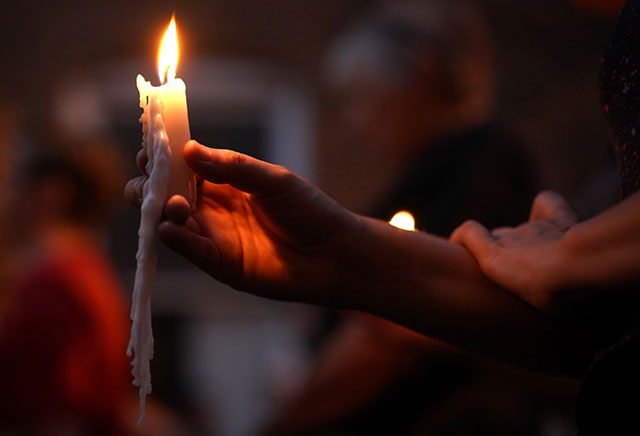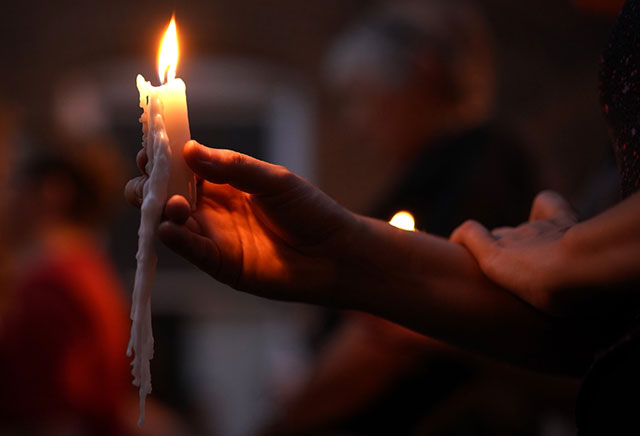
 People raise their memorial candles during a vigil at the location where 32-year-old Heather Heyer was killed when a car plowed into a crowd of people protesting against the white supremacist Unite the Right rally August 13, 2017, in Charlottesville, Virginia. (Photo: Win McNamee / Getty Images)
People raise their memorial candles during a vigil at the location where 32-year-old Heather Heyer was killed when a car plowed into a crowd of people protesting against the white supremacist Unite the Right rally August 13, 2017, in Charlottesville, Virginia. (Photo: Win McNamee / Getty Images)
Last June, the Trump administration rescinded funds previously earmarked to counter right-wing extremism and white supremacist violence. Just two months later, 19 people were injured and protester Heather Heyer was killed by a neo-Nazi demonstrator in the streets of Charlottesville, Virginia. Though Charlottesville has become the most cited example of contemporary right-wing terror, it hardly offers a full picture of the threat posed by those Trump described as “very fine people.”
A new study from the Southern Poverty Law Center finds there have been more than “100 people killed or injured by alleged perpetrators influenced by the so-called ‘alt-right’ — a movement that continues to access the mainstream and reach young recruits.” The SPLC report tracks the rise in alt-right related violence beginning in 2014, when 22-year-old Elliot Rodger murdered six people and injured 14 others in Isla Vista, California. Like many alt-right adherents, Rodger’s radicalization began in men’s rights forums, which helped stoke his racism, misogyny and self-loathing. The study identifies 13 killers who have collectively killed 43 people and injured 67 others. “While some certainly displayed signs of mental illness,” the media tendency to depict these violent right-wing extremists as troubled loners is conveniently misguided. The SPLC notes that the most conspicuous unifying background trait among these individuals is a “history of consuming and/or participating in the type of far-right ecosystem that defines the alt-right.”
A healthy number of those identified in the report are outspoken fans of Donald Trump, the report notes. Nicholas Giampa, who in December murdered his ex-girlfriend’s parents before killing himself, was an “enthusiastic supporter of then-candidate Donald Trump [who] often used racist slurs to attack Trump’s critics.” Charlottesville killer James Alex Fields’ social media pages were reportedly filled with Trump and Pepe memes. A Daily Beast report found Sean Urbanski, the alleged killer of US Army Lieutenant Richard Collins III, “apparently liked memes about Donald Trump, white supremacy, and the alt-right.” Alexandre Bissonnette, the Quebec mosque murderer and the lone Canadian in the group, was reportedly an avid supporter of both Trump and Marine Le Pen. In July 2017, former Breitbart intern Lane Davis stabbed his father to death; a little over a year before, he wrote a rap ode to Trump he posted on YouTube. (Choice lyrics: “Finger on the trigger/Trump might use a nuke, boy/But he’d rather use a tariff/And that’s superb.”)
The alt-right’s visibility has grown alongside Trump’s political career, and the two appear inextricably linked. Nine of the attacks cataloged by the SPLC occurred in the shadow of the Trump presidency, leading the organization to cite 2017 as the most violent year of the alt-right’s existence thus far. Overall, the mean age of far-right killers is 26, with the youngest just 17. Members of the alt-right have been open about their efforts to appeal to young, impressionable minds. An Anti-Defamation League report released late last month noted that there has been a drastic increase in the amount of “white supremacist propaganda — flyers, stickers, banners, and posters — appearing on college and university campuses.” Racism and misogyny have also been allowed to grow unchecked online in spaces such as 4chan and Reddit, and more recently, “alt-tech” sites such as Gab and WASP.love (a racist dating site).
Back in 2009, the Department of Homeland Security published a report on right-wing extremism that warned of increasing violence from militias, hate groups and other right-wing terrorists. Following pushback from GOP lawmakers who leaked the report, as well as their conservative reporters, the document was officially retracted by DHS and “the Extremism and Radicalization Branch was quietly dismantled,” according to the New York Times. Yet multiple recent studies have shown that white nationalists now pose a far greater terrorist threat to the US than ISIL. The Trump administration’s sympathy for the alt-right and other white supremacists and its refusal to counter their terror, means these fanatics will likely only grow more dangerous. Daryl Johnson, the counterintelligence analyst pushed out of the DHS for his prescient report, wrote an op-ed in the Washington Post just after the Charlottesville tragedy, again attempting to offer a warning.
“Neo-Nazis, Ku Klux Klan members, militia extremists, and other radical right-wing zealots march side-by-side at pro-Trump rallies across the country,” Johnson wrote. “Trump’s endorsement of the border wall, the travel ban, mass deportations of illegal immigrants — these ideas were touted on white supremacist message boards merely 10 years ago. Now they’re being put forth as official US policy…Extremists no longer hide anymore. They number in the hundreds of thousands and are extremely well-armed. The political apparatus and the news media appears confused in their reporting of the scope of the domestic terrorist threat — some ignoring it completely. When 9/11 happened, the government made an effort to connect the dots beforehand, but failed because of a lack of communication among agencies. In this case, the government isn’t even trying — and worse, it appears to be enabling the threat to flourish.”
Thank you for reading Truthout. Before you leave, we must appeal for your support.
Truthout is unlike most news publications; we’re nonprofit, independent, and free of corporate funding. Because of this, we can publish the boldly honest journalism you see from us – stories about and by grassroots activists, reports from the frontlines of social movements, and unapologetic critiques of the systemic forces that shape all of our lives.
Monied interests prevent other publications from confronting the worst injustices in our world. But Truthout remains a haven for transformative journalism in pursuit of justice.
We simply cannot do this without support from our readers. At this time, we’re appealing to add 50 monthly donors in the next 2 days. If you can, please make a tax-deductible one-time or monthly gift today.